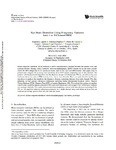Mostrar o rexistro simple do ítem
Eye State Detection Using Frequency Features from 1 or 2-Channel EEG
| dc.contributor.author | Laport López, Francisco | |
| dc.contributor.author | Dapena, Adriana | |
| dc.contributor.author | Castro-Castro, Paula-María | |
| dc.contributor.author | Iglesia, Daniel I. | |
| dc.contributor.author | Vázquez Araújo, Francisco Javier | |
| dc.date.accessioned | 2023-11-30T18:58:27Z | |
| dc.date.available | 2023-11-30T18:58:27Z | |
| dc.date.issued | 2023 | |
| dc.identifier.citation | Laport, F., Dapena, A., Castro, P. M., Diego Fernández Iglesias, & Vázquez-Araújo, F. J. (2023). Eye State Detection using Frequency Features from 1 or 2-Channel EEG. International Journal of Neural Systems. https://doi.org/10.1142/s0129065723500624 | es_ES |
| dc.identifier.issn | 0129-0657 | |
| dc.identifier.issn | 1793-6462 | |
| dc.identifier.uri | http://hdl.handle.net/2183/34401 | |
| dc.description | © The Author(s) This is an Open Access article published by World Scientific Publishing Company. It is distributed under the terms of the Creative Commons Attribution 4.0 (CC BY) License which permits use, distribution and reproduction in any medium, provided the original work is properly cited. | es_ES |
| dc.description.abstract | [Abstract]: Brain–computer interfaces (BCIs) establish a direct communication channel between the human brain and external devices. Among various methods, electroencephalography (EEG) stands out as the most popular choice for BCI design due to its non-invasiveness, ease of use, and cost-effectiveness. This paper aims to present and compare the accuracy and robustness of an EEG system employing one or two channels. We present both hardware and algorithms for the detection of open and closed eyes. Firstly, we utilize a low-cost hardware device to capture EEG activity from one or two channels. Next, we apply the discrete Fourier transform to analyze the signals in the frequency domain, extracting features from each channel. For classification, we test various well-known techniques, including Linear Discriminant Analysis (LDA), Support Vector Machine (SVM), Decision Tree (DT), or Logistic Regression (LR). To evaluate the system, we conduct experiments, acquiring signals associated with open and closed eyes, and compare the performance between one and two channels. The results demonstrate that employing a system with two channels and using SVM, DT, or LR classifiers enhances robustness compared to a single-channel setup and allows us to achieve an accuracy percentage greater than 95% for both eye states. | es_ES |
| dc.description.sponsorship | This work has been supported by Grant No. ED431C 2020/15 funded by Xunta de Galicia and ERDF Galicia 2014–2020; by Grant No. PID2019-104958RB-C42 (ADELE) funded by MCIN/AEI/10.13039/501100 011033; and by project TED2021-130240B-I00 (IVRY) funded by MCIN/AEI/10.13039/501100011033 and by the European Union NextGeneration EU/PRTR and by the postdoctoral Grant No. ED481B 2022/012 funded by Xunta de Galicia. | es_ES |
| dc.description.sponsorship | Xunta de Galicia; ED431C 2020/15 | es_ES |
| dc.description.sponsorship | Xunta de Galicia; ED481B 2022/012 | es_ES |
| dc.language.iso | eng | es_ES |
| dc.publisher | World Scientific Publishing | es_ES |
| dc.relation | info:eu-repo/grantAgreement/AEI/Plan Estatal de Investigación Científica y Técnica y de Innovación 2017-2020/PID2019-104958RB-C42/ES/AVANCES EN CODIFICACIÓN Y PROCESADO DE SEÑAL PARA LA SOCIEDAD DIGITAL | es_ES |
| dc.relation | info:eu-repo/grantAgreement/AEI/Plan Estatal de Investigación Científica y Técnica y de Innovación 2021-2024/TED2021-130240B-I00/ES/DETECCIÓN INTEGRADA DE VÍDEO Y RADAR PARA EL POSICIONAMIENTO EN INTERIORES DE PERSONAS SIN DISPOSITIVOS Y CON GARANTÍA DE PRIVACIDAD BASADA EN EDGE AI | es_ES |
| dc.relation.uri | https://doi.org/10.1142/S0129065723500624 | es_ES |
| dc.rights | Atribución 4.0 International (CC-BY) | es_ES |
| dc.rights | © The Authors | es_ES |
| dc.rights.uri | http://creativecommons.org/licenses/by/3.0/es/ | * |
| dc.subject | Brain–computer interface | es_ES |
| dc.subject | Electroencephalography | es_ES |
| dc.subject | Eye states | es_ES |
| dc.subject | Prototype | es_ES |
| dc.title | Eye State Detection Using Frequency Features from 1 or 2-Channel EEG | es_ES |
| dc.type | info:eu-repo/semantics/article | es_ES |
| dc.rights.access | info:eu-repo/semantics/openAccess | es_ES |
| UDC.journalTitle | International Journal of Neural Systems | es_ES |
| UDC.volume | 33 | es_ES |
| UDC.issue | 12 | es_ES |
| UDC.startPage | 2350062-1 | es_ES |
| UDC.endPage | 2350062-16 | es_ES |
| dc.identifier.doi | 10.1142/S0129065723500624 |
Ficheiros no ítem
Este ítem aparece na(s) seguinte(s) colección(s)
-
GI-GTEC - Artigos [193]






